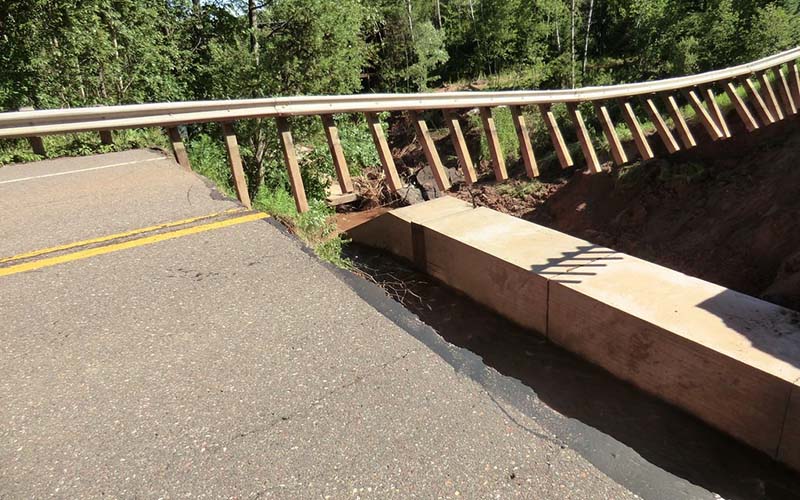Read this in Spanish / lee esto en español
Andrew Teal is a resident of the Town of Barnes, Wisconsin.
Back in 2016 I had few demands on my personal time, so I was willing to meet volunteers just about whenever and wherever they needed me. Nights, weekends, the other end of the county, whatever. Well, I was returning home from a Town of Barnes Aquatic Invasive Species Committee meeting, and passed through Grand View at about 8:45 p.m. That was the approximate halfway point between the Barnes Town Hall and my apartment. The torrential rain had been falling for at least two hours at this point, so even in that relatively sandy area, the water had begun to rise, and road visibility was diminished. Every few seconds I heard the whooshing of the tires ever-so-briefly hydroplaning on that leg of the drive.
Passing over what I would later discover was the Twentymile Creek stream crossing, I saw too late that water had begun to pool in the northbound lane. With no time to react, I hit the water at speed. Fortunately, my Pontiac Grand Am did not stall, despite the rapid deceleration and the no-doubt enormous wave that it generated. I kept a close eye out after that, but not even Bibon Swamp had water over the road during the remainder of the drive home.

The next day, news stories, town road maintenance personnel reports, and social media posts poured in. That’s when I saw photos of the exposed concrete box culvert and 50-foot vertical drop between it and the surface of U.S. Highway 63. That’s when I heard about the sheriff’s deputy that had to radio for help halfway through his shift, escape his patrol vehicle in a flood, and cling to a tree for hours before being rescued. Both of those events happened in the same place I hit the pool of water mere hours earlier.
Questions swirled through my mind like the floodwaters around the road I nearly witnessed blowing out. What if I had driven through there even an hour later and the washout had already occurred? Would I have been able to stop in time, or would I have fallen through the road? If I did fall, would I have been as lucky as that Sheriff’s deputy, clinging to a tree until help arrived? Or would my car have turned into a four-wheeled casket and floated me off to the hereafter?
People might think my recounting of this story is overblown, but I remind them that people died because of that storm. For everyone else, the Northland was essentially closed and cut off from the rest of the region due to the number of roads that got damaged or flooded.
Infrastructure resiliency and wetland restoration (among other ideas) are now hot topics of conversation and funding up here because of the 2016 and 2018 floods. Much of the infrastructure that was damaged or destroyed during that flood (and the flood in 2018) has since been rebuilt. Many of the affected communities operated on budgets that could not handle the necessary repairs though, so the disaster declaration that was finally issued was critical to moving forward with the process. This is still true to some extent, both regarding the budgets and the need for disaster declarations to obtain needed funding for repairs.
It would be quite helpful to have larger pots of money available before disaster strikes, without a ton of bureaucracy attached, so communities and landowners can restore wetlands on their properties and appropriately upsize culverts to handle more intense storms and heavier precipitation events. Paying a little for it now so we can properly prepare makes far more sense than paying a lot later to repair the damage, on top of the economic loss due to road closures and resulting environmental damage from washouts.
This story is excerpted from from the Great Lakes Working Group White Paper, Climate Change and Wisconsin’s Great Lakes Ecosystem (pdf)
Learn More
- Bayfield County Pursues Flood Resiliency to Protect Its Economy
- Bad River Culvert Restoration Program
The views and opinions expressed in this interview are those of the authors and do not represent official policy or position of the University of Wisconsin-Madison or the Wisconsin Initiative on Climate Change Impacts.